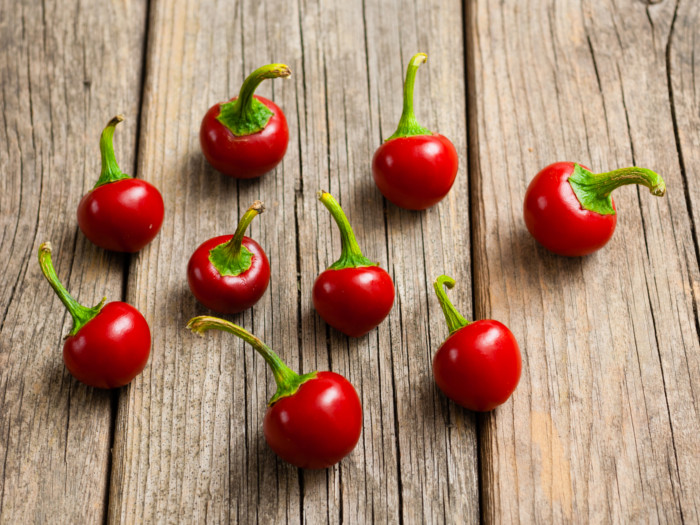Most people know a pimento pepper as the little red fruit stuffed in green olives, but it can also provide all sorts of unexpected health benefits.
What is a Pimento Pepper?
Pimento pepper is the sweet, red chili pepper that grows in a round shape and resembles cherry tomatoes. They are most commonly used to stuff green Manzano olives to balance out the saltiness. After pimentos are pickled or brined, they are often mistaken for roasted red peppers as they have a similar aromatic and succulent flavor. However, unlike bell peppers, pimentos are capsicum peppers, containing a small amount of capsaicin, which produces heat in its flavor. Pimentos are commonly dried and ground to make the spice ‘paprika’. [1]
A one-cup serving of pimento pepper contains many vitamins, minerals, and essential amino acids, but has only 44 calories.

Pimento peppers are not very spicy, very mild and sweet in flavor. Photo Credit: Shutterstock
| Serving Size : | |
|---|---|
| Nutrient | Value |
| Water [g] | 93.1 |
| Energy | 23 |
| Energy [kJ] | 96 |
| Protein [g] | 1.1 |
| Total lipid (fat) [g] | 0.3 |
| Ash [g] | 0.4 |
| Carbohydrate, by difference [g] | 5.1 |
| Fiber, total dietary [g] | 1.9 |
| Sugars, total including NLEA [g] | 2.71 |
| Calcium, Ca [mg] | 6 |
| Iron, Fe [mg] | 1.68 |
| Magnesium, Mg [mg] | 6 |
| Phosphorus, P [mg] | 17 |
| Potassium, K [mg] | 158 |
| Sodium, Na [mg] | 14 |
| Zinc, Zn [mg] | 0.19 |
| Copper, Cu [mg] | 0.05 |
| Manganese, Mn [mg] | 0.09 |
| Selenium, Se [µg] | 0.2 |
| Vitamin C, total ascorbic acid [mg] | 84.9 |
| Thiamin [mg] | 0.02 |
| Riboflavin [mg] | 0.06 |
| Niacin [mg] | 0.62 |
| Pantothenic acid [mg] | 0.01 |
| Vitamin B-6 [mg] | 0.22 |
| Folate, total [µg] | 6 |
| Folate, food [µg] | 6 |
| Folate, DFE [µg] | 6 |
| Choline, total [mg] | 6.3 |
| Vitamin A, RAE [µg] | 133 |
| Carotene, beta [µg] | 1474 |
| Carotene, alpha [µg] | 238 |
| Vitamin A, IU [IU] | 2655 |
| Lutein + zeaxanthin [µg] | 366 |
| Vitamin E (alpha-tocopherol) [mg] | 0.69 |
| Vitamin K (phylloquinone) [µg] | 8.3 |
| Fatty acids, total saturated [g] | 0.05 |
| 14:0 [g] | 0 |
| 16:0 [g] | 0.03 |
| 18:0 [g] | 0.01 |
| Fatty acids, total monounsaturated [g] | 0.02 |
| 16:1 [g] | 0 |
| 18:1 [g] | 0.02 |
| Fatty acids, total polyunsaturated [g] | 0.16 |
| 18:2 [g] | 0.15 |
| 18:3 [g] | 0.02 |
| Phytosterols [mg] | 9 |
| Tryptophan [g] | 0.01 |
| Threonine [g] | 0.04 |
| Isoleucine [g] | 0.04 |
| Leucine [g] | 0.06 |
| Lysine [g] | 0.05 |
| Methionine [g] | 0.01 |
| Cystine [g] | 0.02 |
| Phenylalanine [g] | 0.03 |
| Tyrosine [g] | 0.02 |
| Valine [g] | 0.05 |
| Arginine [g] | 0.05 |
| Histidine [g] | 0.02 |
| Alanine [g] | 0.05 |
| Aspartic acid [g] | 0.16 |
| Glutamic acid [g] | 0.15 |
| Glycine [g] | 0.04 |
| Proline [g] | 0.05 |
| Serine [g] | 0.04 |
| Sources include : USDA [2] | |
Benefits
Pimento peppers have many amazing benefits. Let us take a look at them in detail below.
- Pimento peppers are an excellent source of vitamin C, which is shown to be beneficial in boosting the strength of the immune system. [3]
- Pimento peppers’ high iron content may also explain why they work to alleviate restless leg syndrome.
- The vitamin A in pimentos helps to promote skin health and cell growth by supporting collagen production.
- The vitamin B6 in these peppers protects eye health, while vitamin B2 also helps fight anemia, and B3 prevent arthritis.
- Pimentos contain large amounts of copper, which supports healthy growth and bone development.
- The vitamin K in peppers decreases the risks of internal bleeding and osteoporosis.
Substitutes
Roasted and skinned red bell peppers can be substituted for pimentos in most recipes, and while the flavor differs slightly, the same overall effect is achieved.
Word of Caution: Large amounts of pimentos can cause an upset stomach, and people on blood-thinning medication or who are prone to panic attacks should avoid foods in the chili pepper family. Every person’s sensitivity to this spice is different, so pay attention to your body’s reaction and consume these peppers in moderation!
